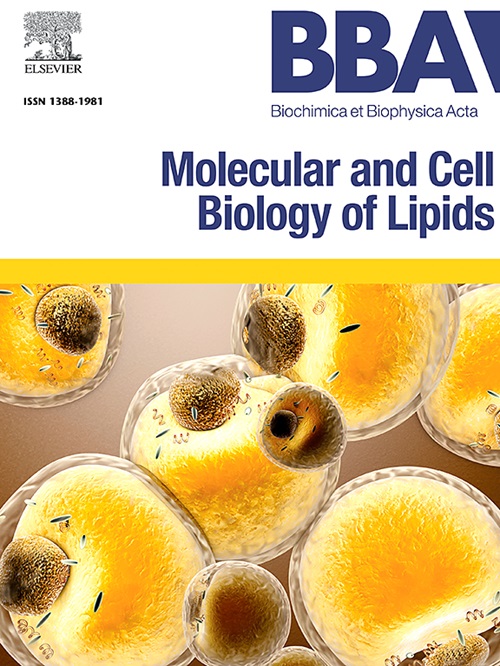层流剪切应力通过上调LPCAT3酶活性促进主动脉内皮细胞中多不饱和脂肪酸的积累
IF 3.3
2区 生物学
Q2 BIOCHEMISTRY & MOLECULAR BIOLOGY
Biochimica et biophysica acta. Molecular and cell biology of lipids
Pub Date : 2025-05-23
DOI:10.1016/j.bbalip.2025.159638
引用次数: 0
摘要
目的内皮细胞(ECs)在组织稳态中起重要作用。血流动力学层流剪切应力参与内皮细胞EC的生理和病理功能。脂质代谢已成为EC功能的潜在调节因子。在这里,我们的目的是破译层流剪切应力在调节人主动脉内皮细胞脂质代谢中的作用。方法与结果将人主动脉内皮细胞(HAOEC)置于层流剪切应力下,观察其脂质代谢的变化。我们发现层流增加了中性和极性脂质的多不饱和脂肪酸(PUFA)含量。脂肪酸组成的这些变化依赖于溶血磷脂酰胆碱酰基转移酶3 (LPCAT3),其mRNA和活性水平在层流剪切应力下特异性上调。脂肪酸摄取也受到剪切应力的调节,部分通过LXR途径。值得注意的是,机械刺激并没有改变脂肪酸的新合成。然而,脂肪酸氧化在层流剪切应力下被上调,涉及AMPK和ACC的磷酸化。这些改变在HAOEC脂肪酸组成最终导致脂质代谢产物的独特模式的释放。综上所述,这些数据表明,层流剪切应力通过激活LPCAT 3酶增加了人主动脉内皮细胞中FA酸的周转。本文章由计算机程序翻译,如有差异,请以英文原文为准。
Laminar shear stress promotes accumulation of polyunsaturated fatty acid in aortic endothelial cells through upregulation of LPCAT3 enzyme activity
Objective
Endothelial cells (ECs) play an important role in tissue homeostasis. Hemodynamic laminar shear stress are involved in both the physiological and pathological function of endothelial cells EC. Lipid metabolism has emerged as a potential regulator of EC function. Here, we aim to decipher the role of laminar shear stress in the regulation of lipid metabolism in human aortic endothelial cells.
Approach and results
Human aortic endothelial cells (HAOEC) were exposed to laminar shear stress, and lipid metabolism was analyzed. We found that laminar flow increased polyunsaturated fatty acid (PUFA) content in both neutral and polar lipids. These changes in fatty acid composition were dependent on lysophosphatidylcholine acyltransferase 3 (LPCAT3), which was specifically upregulated by laminar shear stress at both the mRNA and activity levels. Fatty acid uptake was also modulated by shear stress, partly via the LXR pathway. Notably, mechanical stimulation did not alter de novo fatty acid synthesis. However, fatty acid oxidation was upregulated in response to laminar shear stress, involving AMPK and ACC phosphorylation. These modifications in HAOEC fatty acid composition ultimately led to the release of a distinct pattern of lipid metabolites.
Conclusion
Overall these data revealed that laminar shear stress increased the turnover of FA acid and in human aortic endothelial cells through the activation of the LPCAT 3 enzyme.
求助全文
通过发布文献求助,成功后即可免费获取论文全文。
去求助
来源期刊
CiteScore
11.00
自引率
2.10%
发文量
109
审稿时长
53 days
期刊介绍:
BBA Molecular and Cell Biology of Lipids publishes papers on original research dealing with novel aspects of molecular genetics related to the lipidome, the biosynthesis of lipids, the role of lipids in cells and whole organisms, the regulation of lipid metabolism and function, and lipidomics in all organisms. Manuscripts should significantly advance the understanding of the molecular mechanisms underlying biological processes in which lipids are involved. Papers detailing novel methodology must report significant biochemical, molecular, or functional insight in the area of lipids.

 求助内容:
求助内容: 应助结果提醒方式:
应助结果提醒方式:


